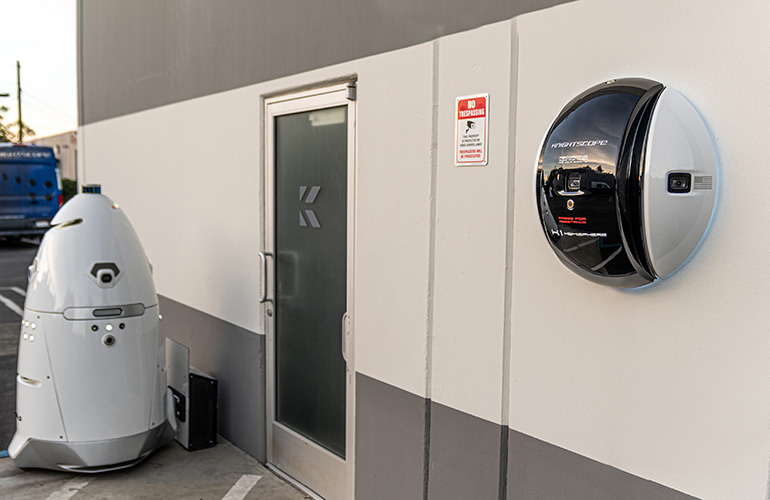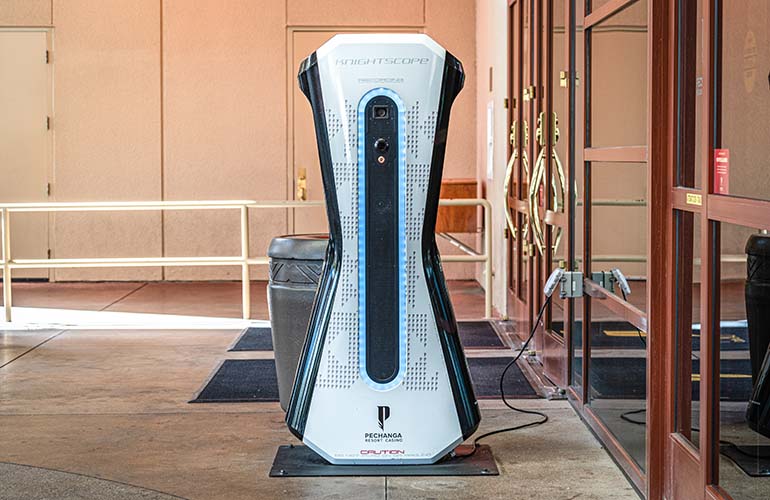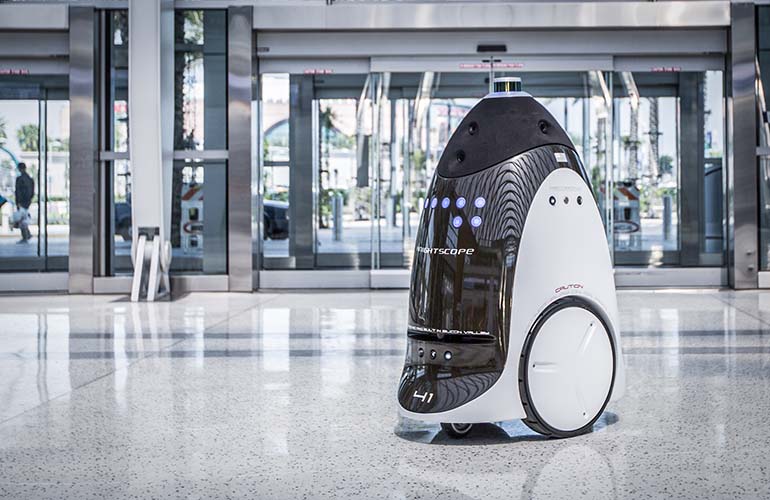|
Listen to this article  |

The K1 Hemisphere (right) is a wall-mounted security solution to be deployed near entrances of facilities. | Credit: Knightscope
Knightscope continues to diversify its portfolio with non-robotic security products. The San Francisco-based company recently introduced its K1 Hemisphere, a compact, stationary, mounted security solution with three cameras that provide 180-degree, eye-level, high-definition video. The solution features automatic license plate recognition and criminal facial recognition called Automatic Criminal Detection Capability (ACDC).
Knightscope is positioning itself as a security provider rather than a robotics manufacturer, and its two latest solutions represent an expansion of the company’s roadmap. Before the K1 Hemisphere, Knightscope in 2017 introduced the K1 Tower, a stationary, kiosk-style implementation of its security technology.
Knightscope has struggled to reach profitability since it was founded in 2013. It began trading publicly on the NASDAQ exchange in January 2022. As a result of being a public company, the books are now transparent. Looking at the recent Form-10Q for Q1 2022, the data exposes this struggle.
The company charges up to $7 per hour to deploy its autonomous security robots (ASRs) and, until recently, wrote those contracts based on a 24/7 deployment. This means each robot brings in a maximum of about $62K in annual recurring revenue (ARR) for the company. Recognizing that revenue every quarter means each robot earns about $15K in quarterly recurring revenue (QRR).
Looking at the revenue for Q1 2022, Knightscope brought in $944,000 compared to the same quarter in 2021 where it earned $866,000, a positive delta of $78,000. However, given the average QRR, this implies that the company only deployed three additional robots from Q1 2021 to Q1 2022. During Q1, the cost to deploy was $310K. So the company spent $310K to earn $78K (or $4 for every $1 of revenue) in Q1. What’s not clear is how much of this operational cost is fixed and how much is variable based on the deployment of each subsequent robot.
Since the beginning of 2022, the company has announced 40+ new contracts, so we’ll have to wait for the Q2 numbers to see the results of these new deployments. However, if the costs to deploy scale similarly, then the company will be digging an even deeper hole.
New revenue streams
All of this is to say Knightscope needed additional revenue streams. The new K1 Hemisphere is an addition to the product portfolio that will enable upselling of future and existing customers with additional Knightscope solutions. It’s easy to imagine that each K3/K5 robot will drag an additional 5-10 K1 Hemispheres to the account (to cover each ingress/egress point on a property).
With an introductory price of $0.75 per hour on an annual contract, the K1 Hemisphere provides a cost-effective security solution for companies. For an additional $2 per hour, Knightscope+ remote monitoring services are available as an option.
Knightscope’s K1 Hemisphere is designed for commercial property owners, residential, bank ATMs, truck stops, lobbies, loading docks, ports, rail, schools, and more. The compact size and affordable subscription price make it an attractive entry point to deploy Knightscope’s advanced security technology. The K1 Hemisphere will begin shipping later this year.
“Over the next three decades, you should expect a very wide portfolio [from Knightscope] with solutions of every size and form factor that you could possibly imagine,” Knightscope chairman and CEO William Santana Li told The Robot Report. “We plan to put these devices into every nook and cranny, indoors and outdoors, on the corner of a federal courthouse, through an entire city or on a highway and everything in between. All these machines should be able to see, feel, hear and smell and do 100 times more than a human (security guard) could ever possibly do.”
William said the robotics industry focuses too much on robotics technology and not enough on solving customer problems. Part of the mission for the K1 Hemisphere is to be able to provide eyes, ears and voices on the ground in multiple locations simultaneously for the officers and guards to do their jobs much more effectively.
“I don’t think the founders of this country ever expected us to build a society where going to work, going to school, or going to a movie theater literally came with the risk of being shot or killed,” William said. “That’s not acceptable.”
For a use case like a school or corporate campus, the ideal situation would be to position a (stationary) Knightscope K1 tower at the ingress/egress to the parking lot, combined with a Knightscope K5 ASR patrolling in the parking lot. The K1 Hemisphere watches entrances and exits of buildings for extra coverage of the interior of a facility.

The K1 tower is a stationary, kiosk-style implementation of Knightscope’s security technology. | Credit: Knightscope
William said Knightscope releases new software features every two weeks. The company tries to release new hardware every 3-6 months. Features like visible weapon detection and acoustic gunshot detection are all feasible today. According to Knightscope, the roadmap for K1 Hemisphere will include features like gunshot detection and triangulation.
“I think we’re doing really well, in casinos and hospitals, commercial real estate, corporate campuses, some schools and cities, and law enforcement,” said William. “PG&E recently doubled their order, due partly to the ROI they are experiencing.”
He said supply chain issues are currently one of the biggest issues for the company, calling it a massive “Whack a Mole” problem.
William said the company is constantly chasing supply chain issues for its manufacturing line. He said the company has an order backlog of several million dollars. He added that Knightscope is taking the necessary steps to acquire, and in some cases even hoard, the materials required to stay on pace to deliver customer orders.
Knightscope’s machine-as-a-service (MaaS) business model means it can’t recognize revenue until the equipment is deployed in the field and operating for clients.

The Knightscope K3 tower is a mobile indoor version of the Knightscope security technology. | Credit: Knightscope
Credit: Source link


Comments are closed.